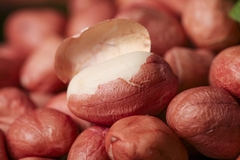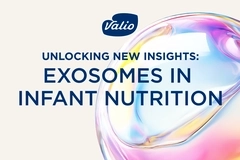Kerry pegs plant-based infant formula for growth despite regulatory hurdles
15 Apr 2022 --- Although plant-based infant formulas have existed for over a century, it is in the last two decades that demand has grown significantly. Now, research-backed ingredients can offer all the nutrients babies need, Inaki Mielgo, vice president of business development for plant proteins at Kerry Taste & Nutrition, tells NutritionInsight.
“Compared to previous years, we are definitely seeing increased sales of plant-based infant formulas and more product innovations launching on the market,” he explains.
Soy formulas date back a hundred years and are now found on a global scale across all regions. Meanwhile, rice-based formulas are mostly found in Europe, Australia, Asia, the Middle East and Latin America.
“In our experience, we are seeing many traditional dairy infant milk formula producers expanding their product development pipelines to include plant-based solutions for infants as well as for toddlers,” says Mielgo.
 While Europe is the center for cow milk allergy treatments, these products are also migrating to other continents.What’s behind the demand?
While Europe is the center for cow milk allergy treatments, these products are also migrating to other continents.What’s behind the demand?
The main reason for selecting a plant-based formula is when there is a sensitivity to dairy. Mielgo notes this could include lactose intolerance, cow’s milk protein allergy or anti-regurgitation.

“Parental values and the growing support of plant-based food is also expected to drive increased uptake.”
There has been a significant movement toward more environmentally friendly protein sources, with many parents now identifying as vegans or flexitarians.
In addition, there are perceived positive health benefits around plant proteins, coupled with increasing levels of lactose intolerance and cow’s milk allergies.
However, UK researchers recently flagged that the overdiagnosis of Non-IgE-mediated cow’s milk allergy in children may be leading to unnecessary prescriptions of specialized formula milks.
Assessing varieties
There are also different reasons behind the use of soy-based and rice-based formulas.
In the case of soy-based formulas, initial use was mainly driven by the US and Asia as alternative formulas to be recommended in cow’s milk allergy treatment, when a dairy product cannot be recommended even if hydrolyzed.
In the case of the new generation of rice-based formulas, Mielgo explains the market is selecting this solution for several reasons.
“First of all, rice is a well-known plant source. The amino acid profile in rice proteins delivers the plant-based proteins most similar to breast milk. Additionally, rice-based formulas are neutral-tasting, hypoallergenic and can offer both conventional and organic varieties.”
Beyond protein sources, making a plant-based formula also means addressing ingredients that are often animal-derived, like DHA and EPA. Therefore, vegetarian solutions may be used instead.
Satisfying nutritional needs
Although plant-based formulas have previously come under fire, Mielgo believes that they still provide all the required nutrients.
“Whether they are dairy or plant-based, all infant formulas need to have certain specific ingredients added to ensure they are fit for the intended purpose. They need to satisfy the nutritional requirements of infants. For example, this could entail having specific amounts of vitamins and minerals or certain oils for the fatty acids they provide.”
Depending on the plant source, there may be deficiencies of certain components in the protein where certain amino acids could be missing.
“Processing and fortification may be needed in order to meet the nutritional composition required by the regulatory body and the market,” he explains.  Soy and rice are the main plant protein sources used and studied as alternatives to dairy proteins.
Soy and rice are the main plant protein sources used and studied as alternatives to dairy proteins.
Navigating regulation
The regulatory parameters have become increasingly challenging, according to Mielgo. The regulations for infant formula are very specific and strict, ensuring that all ingredients used are safe and that the use and suitability of ingredients are demonstrated by generally accepted scientific data.
Furthermore, the EFSA has published scientific and technical guidance for industry covering a range of related topics, including novel foods and foods for special medical purposes.
“This scientific justification requires a large investment by industry to introduce plant-based formulas in the general infant nutrition market,” says Mielgo.
He adds that the safety criteria covered in legislation for infant products and foods for specific medical purposes are generally much tighter than those for the general population due to the vulnerability of those consumer groups.
The base ingredient can make a big difference – soy and rice both have a significant base of research.
“Introducing another protein source such as pea would take years of research and clinical trials but can be done. It just takes time.”
Weighing further challenges
Additionally, plant proteins require more technical processing to match the performance of dairy formulas and meet the regulation requirements. These include reducing the heavy metal contaminants that can come from the soil or agricultural processes used to grow the crops.
Other challenges can lie in taste as plant proteins often have off notes. This can be increasingly challenging, depending on the levels of processing needed.
“Additionally, plant proteins are inherently insoluble, and therefore processing is required to improve solubility, texture and stability when prepared in applications.”
What lies ahead?
Based on consumers’ current drive for sustainable plant-based formulas, Mielgo expects that these products will continue to grow.
“We will see an increased migration of these products from the pharmacy channel onto general retail shelves. Additionally, innovative ingredients will be added to plant-based formulas to enhance the health benefits to the infant. We will also observe more consumer communication about the many positive nutritional factors of plant-based formulas,” he predicts.
The next steps for industry are now to continue to invest in clinical trials, innovation, research and development of current plant sources. “It must also diversify into other interesting and sustainable plant-protein sources such as pea, canola, flax and others as well.”
By Katherine Durrell















